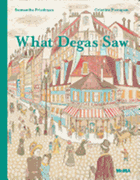
When Edgar Degas (1834-1917) was living in Paris, he used to gaze down onto the bustling street from his studio window and wonder why he persisted in painting pictures of cloth-draped figures and ancient wars and not "the beauty of the passing moment."
In the splendid picture book What Degas Saw by Samantha Friedman (Matisse's Garden), visions of the caped Degas on his Parisian wanderings--from laundries to theaters--are deftly captured in "aquatint etchings" by Italian illustrator Cristina Pieropan, then juxtaposed with reproductions of the artist's actual paintings. This is a rare opportunity for readers to see an artist's close observation and creative interpretation at work. Degas loved to watch people: "We are made to look at each other, don't you think?" At the Opera House, "dancers performed glorious ballets on the wide wooden stage." Here, several of Degas's ballet paintings, such as Pas battu, are reproduced, with brief descriptions of the fleeting moment the artist caught, "like the moment at the peak of a ballerina's jump...." Pieropan's illustrations--expansive, richly textured, full-bleed spreads, detailed in careful, fine lines--are lovely. Her beautiful rendering of the dancers backstage, "[a] quieter kind of dance," is followed by one of Degas's paintings, Frieze of Dancers, showing ballerinas tying the ribbons of their slippers.
Friedman's text, artful and elegant, is perfectly choreographed with the artwork and design. The author finds just the right words for Degas's impulse to "try to describe the city's push and pull, its run and jump, its lean and stretch." A work of art. --Karin Snelson, children's & YA editor, Shelf Awareness

